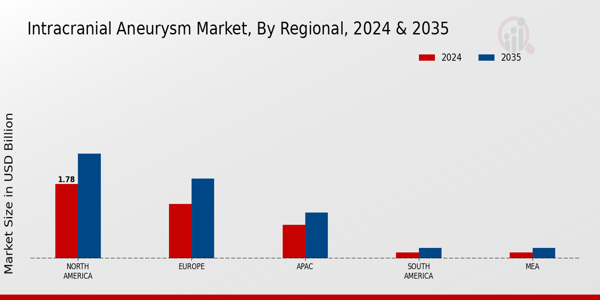Increased Awareness and Screening
In recent years, there has been a marked increase in awareness regarding intracranial aneurysms, which is positively impacting the Intracranial Aneurysm Market. Public health campaigns and educational initiatives have contributed to a better understanding of the risk factors and symptoms associated with aneurysms. This heightened awareness is leading to more individuals seeking screening and diagnostic imaging, such as MRIs and CT scans. Data indicates that the number of screenings has risen, correlating with an increase in early detection rates. Consequently, this trend is expected to drive the demand for treatment options, as more patients are diagnosed with aneurysms that require intervention. The growing emphasis on preventive healthcare is likely to further bolster the Intracranial Aneurysm Market in the coming years.
Emerging Markets and Economic Growth
Emerging markets are becoming increasingly relevant to the Intracranial Aneurysm Market, driven by economic growth and improving healthcare access. Countries with developing economies are witnessing a rise in healthcare expenditure, which is facilitating the adoption of advanced medical technologies and treatments for intracranial aneurysms. As these markets expand, there is a growing demand for both diagnostic and therapeutic solutions. For instance, the introduction of affordable endovascular devices is likely to enhance treatment accessibility in these regions. Furthermore, partnerships between local healthcare providers and international medical technology companies are expected to foster innovation and improve patient care. As economic conditions continue to improve, the Intracranial Aneurysm Market is poised for growth in these emerging markets.
Technological Advancements in Treatment
The Intracranial Aneurysm Market is experiencing a notable transformation due to rapid technological advancements in treatment modalities. Innovations such as minimally invasive surgical techniques, advanced imaging technologies, and the development of new endovascular devices are enhancing patient outcomes. For instance, the introduction of flow diverters and stent-assisted coiling has revolutionized the management of complex aneurysms. According to recent data, the market for endovascular devices is projected to grow significantly, driven by these advancements. Furthermore, the integration of artificial intelligence in diagnostic imaging is expected to improve the accuracy of aneurysm detection, thereby increasing the demand for advanced treatment options. As these technologies continue to evolve, they are likely to play a pivotal role in shaping the future of the Intracranial Aneurysm Market.
Aging Population and Associated Health Risks
The aging population is a significant driver of the Intracranial Aneurysm Market, as older individuals are at a higher risk for developing aneurysms. As life expectancy increases, the prevalence of age-related health conditions, including hypertension and atherosclerosis, also rises, contributing to the incidence of intracranial aneurysms. Data suggests that the demographic shift towards an older population will lead to a corresponding increase in the number of diagnosed cases. This trend is likely to create a greater demand for both surgical and non-surgical treatment options. Additionally, healthcare providers are focusing on developing tailored treatment protocols for older patients, which may further stimulate growth in the Intracranial Aneurysm Market as they seek to address the unique challenges posed by this demographic.
Rising Investment in Healthcare Infrastructure
The Intracranial Aneurysm Market is benefiting from rising investments in healthcare infrastructure across various regions. Governments and private entities are increasingly allocating funds to enhance healthcare facilities, particularly in neurology and neurosurgery departments. This investment is crucial for the development of specialized centers equipped with advanced diagnostic and treatment technologies. For example, the establishment of comprehensive stroke centers has been linked to improved patient outcomes for those with intracranial aneurysms. Furthermore, the expansion of healthcare infrastructure is likely to facilitate better access to care, thereby increasing the number of patients receiving timely treatment. As healthcare systems continue to evolve, the Intracranial Aneurysm Market is expected to experience substantial growth driven by these infrastructural improvements.


















Leave a Comment